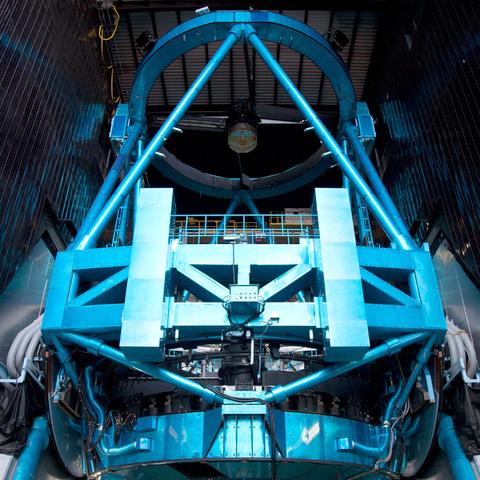Subaru Telescope helps pinpoint origin of ultra-high energy neutrino

Subaru Telescope. Credit: NAOJ
On September 22, 2017 the IceCube experiment at Amundsen Scott station in Antarctica detected an ultra-high energy neutrino coming from outer space and was able to determine the direction it came from to within about 1 degree using the system developed by researchers at Chiba University.
While narrow compared to the entire sky, 1 degree still contains many possible candidates for the source object.
OISTER, a network of Japanese university telescopes, collaborating with the 8-m Subaru Telescope in Hawai?i, performed follow-up observations to determine the source of this enigmatic neutrino. They found that an object named TXS 0506+056 was acting peculiarly: shining 3 times brighter than normal and fluctuating more than usual.
TXS 0506+056 is a blazer, superheated matter releasing abundant radiation as it slowly spirals down into a supermassive black hole.
A quick calculation showed that the odds of two freak occurrences (the ultra-high energy neutrino and a flaring blazer) occurring so close together in time and space by pure chance is effectively zero, unless the two phenomena are related. Therefore TXS 0506+056 must be the source object of the neutrino.
Prof. Michitoshi Yoshida, the Director of Subaru Telescope comments, “We congratulate all members of the IceCube and OISTER teams on this important discovery.
We are proud that the Subaru Telescope with its deep observation capability could play a small role in this discovery. In this era of multi-messenger astronomy, collaboration between different observing facilities will be increasingly important. We look forward to working with this team more in the future.”
Media Contact
All latest news from the category: Physics and Astronomy
This area deals with the fundamental laws and building blocks of nature and how they interact, the properties and the behavior of matter, and research into space and time and their structures.
innovations-report provides in-depth reports and articles on subjects such as astrophysics, laser technologies, nuclear, quantum, particle and solid-state physics, nanotechnologies, planetary research and findings (Mars, Venus) and developments related to the Hubble Telescope.
Newest articles

“Nanostitches” enable lighter and tougher composite materials
In research that may lead to next-generation airplanes and spacecraft, MIT engineers used carbon nanotubes to prevent cracking in multilayered composites. To save on fuel and reduce aircraft emissions, engineers…

Trash to treasure
Researchers turn metal waste into catalyst for hydrogen. Scientists have found a way to transform metal waste into a highly efficient catalyst to make hydrogen from water, a discovery that…

Real-time detection of infectious disease viruses
… by searching for molecular fingerprinting. A research team consisting of Professor Kyoung-Duck Park and Taeyoung Moon and Huitae Joo, PhD candidates, from the Department of Physics at Pohang University…





















